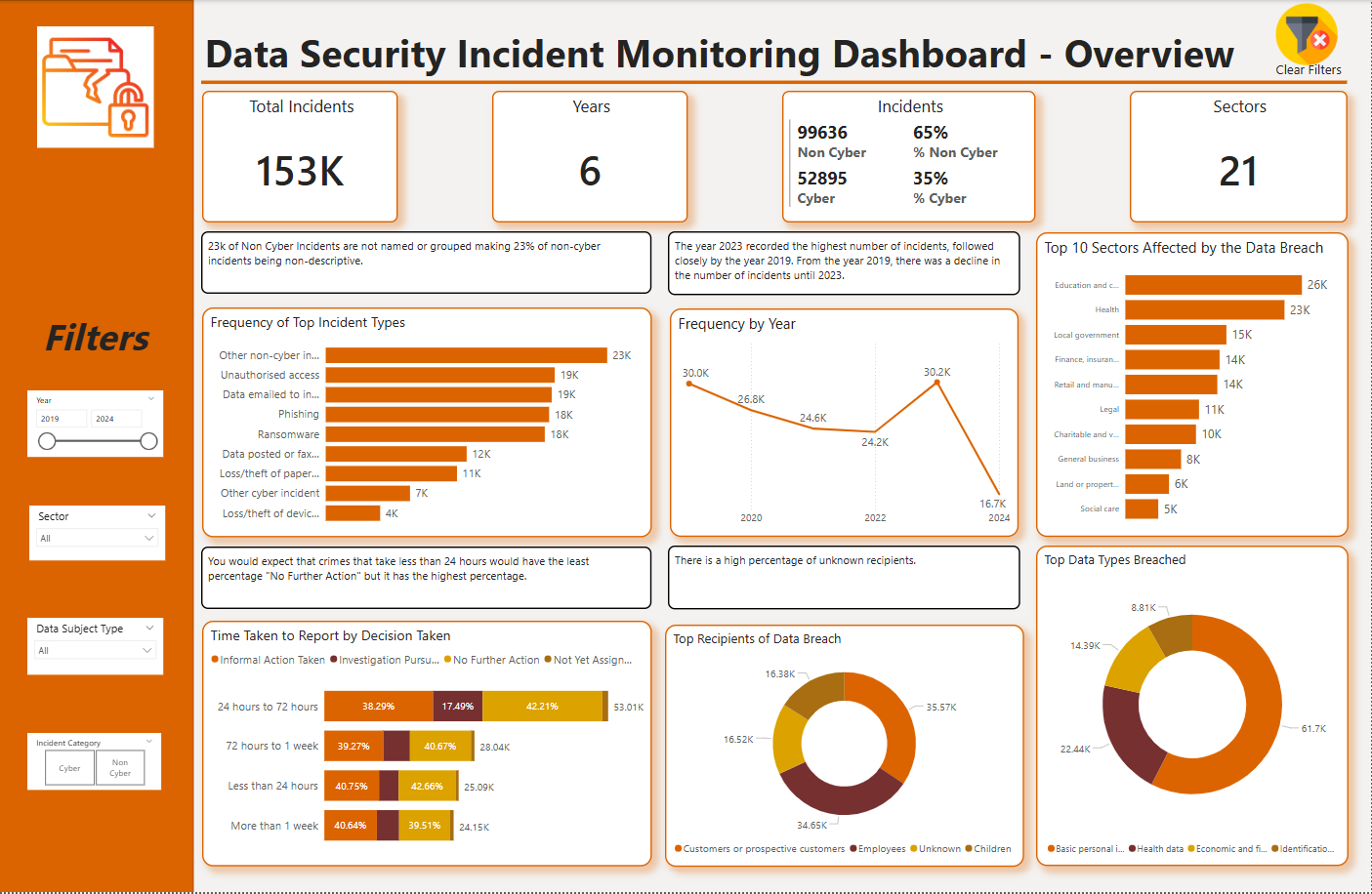Decoding Data Security Incidents – Insights from the ICO Dataset

Introduction: Unmasking the Patterns of Data Security Breaches
In an era where data is the new currency, security breaches are more than just IT issues,they represent financial risks, regulatory headaches, and reputational nightmares. But how do these incidents unfold? Are cyber threats the biggest culprits, or do human errors play an even greater role?
Using a Power BI-driven analysis of the UK Information Commissioner’s Office (ICO) dataset, I explored over 152,000 recorded data security incidents spanning multiple years, sectors, and threat categories. The results? A compelling story of progress, setbacks, and the ongoing battle against data vulnerabilities.
Understanding the Trends: A Rollercoaster of Data Incidents
At first glance, the dataset tells a story of fluctuating security challenges.
2019–2021: A steady decline in incidents from 30,000 to 24,602 suggested an improvement in security measures.
2022: A period of stability, with numbers remaining around 24,199.
2023: A sharp spike to 30,173 incidents—an alarming reversal that may indicate a rise in cyber threats or insufficient security adaptation.
2024: A significant drop to 16,740, the lowest level recorded, perhaps due to stronger cybersecurity initiatives.
But this wasn’t just a yearly pattern. A deeper look into quarterly trends revealed a consistent decline from Q2 to Q4 every year. Was this due to improved security awareness mid-year? Or did seasonal patterns play a role? While the cause remains speculative, the insight was clear: incident management tends to improve as the year progresses.
Cyber vs Non-Cyber Incidents: The Unexpected Heavyweight
When discussing data security incidents, cyberattacks often dominate the conversation. However, this analysis revealed a surprising reality:
- Non-cyber incidents were nearly double the number of cyber incidents, accounting for a staggering 99,636 cases.
- Cyber incidents, while significant, stood at 52,895 cases—reinforcing the need to address security risks beyond the digital realm.
The most frequent cyber threats?
Phishing (18,306 cases)
Ransomware (17,951 cases)
Malware (2,339 cases)
But it was the non-cyber incidents that truly stood out:
Unauthorized access (12,767 cases)
Data emailed to the wrong recipient (18,520 cases)
Loss/theft of paperwork (10,757 cases)
The lesson? While cyber risks like phishing and ransomware remain significant, traditional risks such as misdirected emails and lost paperwork continue to be alarmingly common. Organizations must balance their cybersecurity strategies with robust internal data handling policies.
Who’s at Risk? The Sectors Facing the Most Incidents
Some industries bear the brunt of data breaches more than others. The top offenders included:
- Education & Childcare – A sector vulnerable to mishandled student records and staff data.
- Healthcare – Patient data breaches remain a critical challenge.
- Local Government, Finance, and Retail – Handling vast amounts of sensitive data makes these sectors frequent targets.
On the other hand, sectors with the least reported incidents included political organizations and unknown classifications, possibly due to lower data exposure or stricter access controls.
Key Takeaways: A Call to Action for Better Data Security
This analysis doesn’t just tell a story—it highlights critical lessons for organizations handling sensitive data:
- Strengthen Cyber Defenses – With phishing and ransomware on the rise, enhanced employee training and cybersecurity protocols are essential.
- Address Internal Data Handling Risks – Non-cyber incidents (e.g., unauthorized access, email errors) are alarmingly frequent and require better internal controls.
- Improve Incident Reporting Speed – While many incidents are reported quickly, organizations must ensure compliance with GDPR’s 72-hour rule.
- Sector-Specific Security Enhancements – Education, healthcare, and finance require tailored security strategies to mitigate risks.
By translating data into actionable insights, this Power BI-driven analysis showcases the power of data analytics in understanding and mitigating security risks.
In today’s world, data breaches are not just an IT issue—they are a business risk, a legal concern, and a reputational challenge. The question is no longer if a breach will happen, but how well an organization is prepared to handle it.
